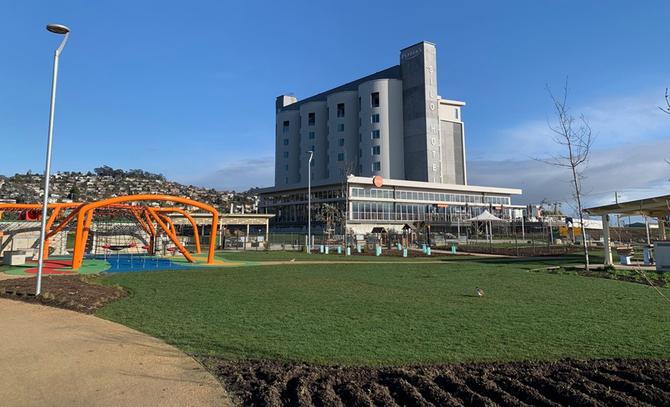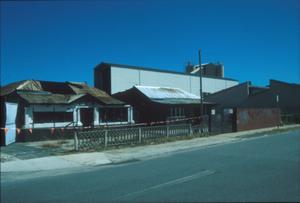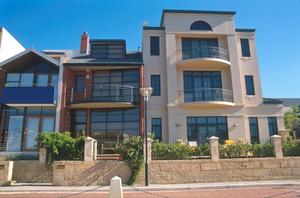The University of Tasmania is moving into Hobart’s city centre. This move began in the 1980s with the School of Creative Arts and Media in Hunter Street. The Menzies Institute moved into its urban home in the late 2000s. More recently, the Institute for Marine and Antarctic Studies (IMAS) set up on Princes Wharf in 2014. With these moves came changes to the look and feel of buildings and surrounding urban spaces, including shifts in how land is used and how people get around.
While changes to urban spaces in cities can be controversial, some changes have broad acceptance. An example is the adaptive re-use of the grain silos on the Hobart waterfront for apartments in 2001. Another example is the repurposing of the Kings Wharf grain silos in Launceston in 2018 for a new hotel, together with a regionally important parkland, with facilities for all ages. Few would say such changes were bad for their communities and cities. But other changes can create tensions among some residents. The Museum of Old and New Art (MONA) was controversial when it first opened but is now loved by many locals – and is internationally celebrated.

Former grain silos in Launceston (Jason Byrne)
While urban changes can feel difficult, they can create new opportunities. The East Perth redevelopment project in Perth, Western Australia is an example. It decontaminated polluted land, created new types of housing, established high quality greenspaces, and revitalised urban areas that had fallen into disuse and disrepair.

East Perth housing before (Jason Byrne)
The redevelopment was not without its problems. The project was unable to achieve the intended social housing target (10-15% intended; around 8% delivered) and lower-income residents were displaced as the area gentrified. Overall, the project site is much better than the former asbestos-ridden power station, abandoned gasworks, obsolete light industrial areas, vacant car-yards, and contaminated waterways.

East Perth housing after (Jason Byrne)
So how can planning generate net positive benefits and limit negative impacts? In the 1990s, the Commonwealth Government’s Building Better Cities (BBC) Program aimed to improve the urban core of Australia’s cities. The $816 million program of federal and state funding created opportunities for new ways of living in, and moving around, cities like Perth, Brisbane, Newcastle, and Adelaide. The BBC initiative responded to the so called ‘doughnut city’ problem. Commercial vacancy rates at that time were very high (e.g., 32% in Perth CBD; 27% Melbourne CBD). Workers would commute into Australian cities in the morning to office jobs and light manufacturing jobs. They would leave in their droves at day’s end, heading home to the suburbs. City centres emptied out at night - people regarded them as ‘dead zones’. Freeways and other roadways were congested at peak hour but had surplus capacity for the rest of the day. The planning solution was to change how city centres were used.
If you walk around downtown Perth, Brisbane, Adelaide, and Newcastle today, you’ll see medium density housing and apartment buildings as well as leafy green parks where once there were empty lots, surplus carparks, and abandoned or vacant light industrial buildings. You’ll also see hotels that were once office buildings. And you’ll see cafés that were once petrol stations and automotive repair yards. Florists and hairdressers have replaced warehouses; former factories are now gyms, galleries, and live music venues. You’ll also see electric rail and bus rapid transit in some of these cities, where there were once noisy and polluting diesel trains and buses.
Tasmania’s larger cities are now experiencing new waves of change. After many years of economic stagnation, shifts are underway in the wider Tasmanian economy, with flow-on effects for our major settlements. In Hobart and Launceston, we can see open air parking lots being converted into much needed apartments and housing. Older industrial building such as flour mills and warehouses have been turned into boutique hotels and co-working spaces. And derelict sites are being remade into micro-breweries and restaurants. These trends reflect broader economic shifts, such as changes to manufacturing jobs and the rise of new jobs in the creative arts, service sector and tourism, hospitality, and leisure.
Some changes in Australian cities also reflect changes in the higher education sector. Access to education is the foundation for economic prosperity and social well-being. But decades of government cuts to university funding have left many universities looking for creative new financial models to provide students with a high-quality educational experience. In Adelaide, Perth, Darwin, and Newcastle, for example, universities have been relocating to city centres – or expanding their city operations.
Moving university campuses to cities can be transformative.
Moving university campuses to cities can be transformative. Students can access more varied jobs in ways that are efficient for their time management. They are closer to opportunities for work-integrated learning. Students have better access to, and more choice, in facilities and services. In new university buildings they can access state-of-the-art equipment and high-quality student lounges, as well as purpose-built student housing. And the revitalised night-time economy brings more entertainment options and major benefits for small business too. Evidence shows that makes for a safer city precinct.
For Hobart, the UTAS move to the city has many benefits, such as breathing new life into the Forestry Building. It also means that the University can continue to deliver high-quality educational experiences. The Sandy Bay campus redevelopment will provide a secure, long-term funding stream, enabling UTAS to deliver its core mission, regardless of government funding changes. And learning valuable lessons from places like East Perth, the Sandy Bay campus transformation can deliver much needed housing and upgraded sports grounds and community facilities while protecting wildlife habitat. From a planning perspective, this makes good sense.
